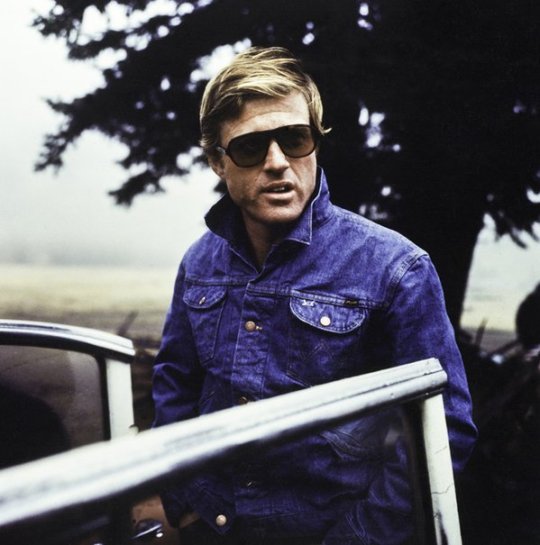Text
The Killing of a Sacred Deer

When I go to see a comedy or a horror movie I expect it to work within the constructs of it’s label. To present the cinematic DNA involved in the formula of it’s Genre. I expect to sink back in my chair and hid the fact that I’m plugging my ears while waiting for the killer or demon to reveal itself. I expect to laugh or smile when inspector Clouseau and Kato go round 4. I expect a feeling to come over me, a warmth and jitter to my stomach, a nervous lump in my throat. I want my palms to sweat, to gasp for breath and flinch while I white knuckle the closest thing to me. Horror movies, comedies, whatever the genre as viewers we all want to be convinced that what we’re watching has someone behind it who meant it. Direction that wants the feeling to translate from screen to seat, to get a what we all go to the movie’s for, a reaction.
The biggest problem with anything I’ve seen from Lanthimos is his apathy, his intentioned lack of interest and enthusiasm in what he’s doing. Relating back to my first paragraph, to call the Lobster a comedy seems ridiculous, to call killing of a sacred deer a horror movie the same. All the ingredients are there but the cake isn’t baked right. I hated the Lobster, loved the concept, even loved Ferral and John C. Reily at times but I couldn’t get behind it. When I first saw Dog Tooth I was told it was a comedy, I hate every single second of that movie. Didn’t even so much as grin or chuckle once through it. Somehow though, after all I’ve said leading up to this I didn’t hate Killing of a Sacred Deer. I was invested, I watched with interest, I just simply didn’t care about it, not swayed one way or the other but not enraged or bothered enough by it to say I hate it. I did find myself intrigued and watched closely, occasionally finding myself distracted by something else in the room. In the end I was underwhelmed and unsatisfied, I expected my skin to crawl and stomach to churn considering all the hype on how gruesome and horrific it was.
When you write a movie motivated by revenge you want your characters to become people a viewer can get behind, someone the audience can feel for, someone you love or hate or can at least sympathize with on some level. I didn’t care about anybody in this movie because Lanthimos writes them so indifferent and monotonous. Even their faces are blank and subdued, not once do the children crack a smile or change the tone in which they droll and babble on. Ferral himself delivered lines like he was reading for someone else auditioning for a lead role. The circumstances surrounding this movie are atrocious for sure, by all means anybody should have sympathy for these people but Lanthimos doesn’t present people with any semblance of humanity. How can you feel for someone that doesn’t seem to care about themselves, that’s robotic and lifeless. Maybe one day Lanthimos will make something that really strikes me but I honestly doubt it.
0 notes
Text
Cop Car (2015)

We've all been told when we were kids that if you touch the stove when it’s hot you’re bound to get burned. If you were a stupid little shit like me than i’m sure you touched it and just as Mommy predicted you got burned. It’s the classic example, warning of child’s curiosities paralleled by curiosity killed the cat, unfortunately for us human beings we don’t have the luxury of 9 lives.
Cop Car opens with still shots of desert shanty’s and trailers, suddenly we’re taken to the desert where we hear the word “weiner”, it echoes again through the desert “weiner”, this time in a different voice. The camera pans over to two boys, Harrison (Hays Wellford) and Travis (James Freedson-Jackson). The boys are fresh into there journey, where are they going? They’re running away to no destination in particular. A wonderful childhood whim i’m sure many children, like myself have either tried or threatened to do. The potty mouthing continues from “boobs” all the way to “fuck”, the worse of the swears that Harrison draws a line on. After the curse-off they’re immediately met with an abandoned cop car in a small ravine. They hit the deck, assuming as any child would that the cops are out to get them for running away. They tread lightly through the bramble, keeping they’re distance and admiring the vehicle like Powatan Indians watching John Smith land in the new world. Travis gathers the courage to throw a rock towards the car to get a reaction, none come. Eventually both boys take turns running up and touching it before running back to cover. After some hard and heavy kid logic the boys the boys decide to approach again. The camera reveals a beer can on the hood, it’s sweating, alluding the audience that someone isn't far off. Some more priceless acting and dialogue takes place before the boys step in and go for a joy ride, niether one of them having ever stepped foot behind a wheel or atop a gas pedal.
Cut to Sheriff Kretzer (Kevin Baconator) sipping a cold one. It looks like a much needed guzzle as he steps out of his cruiser and removes his standard issue police button down. Sheriff Kretzer places his beer on top of the hood than takes to the trunk where he “removes some things” and proceeds to engage in some shady cop stuff. After all’s said and done he returns to his car to find his can on the ground and an empty patch of land where the car used to be. It dawns on us what’s happened, that our boys Harrison and Travis have scooped up the wrong cops cruiser and suddenly we have ourselves some simple and delicious conflict.
Cop Car, much like “Stand by Me” and “The Sandlot” is a coming of age story. It’s ultimate success rides on the dichotomy of the two worlds presented, Harrison and Travis embodying the innocence of youth and Sheriff Kretzer the cruel, selfish, and manipulative nature of man. Watts handles both worlds like a marksmen, allowing the audience to marinate in the gravity of Sheriff Kretzers situation while simultaneously relishing at how oblivious Harrison and Travis are of there own. A truly impressive feat for a second feature.
The script, though bare bones is original and unique in the way it informs the audience just enough while giving away very little. It presents only a few “Who’s” to focus on while making the “Why” evidentially clear in the end. Watts attention to detail specifically to Sheriff Kretzer is impeccable. He shows clever resourcefulness while Kretzer navigates his predicament, trying desperately to regain control and locate his vehicle, maintaining a level head to others while boiling up inside. The end rivals some of the great western showdowns as Harrison and Travis are forced very quickly to graduate from adolescence into adulthood. Cop Car hands down is one of my favourite films of 2015, and continues to be the more flicks of last year I see.
0 notes
Photo
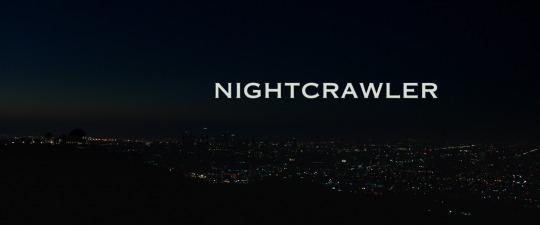

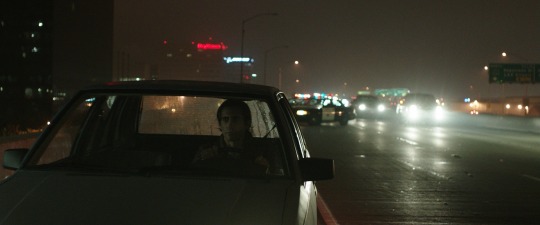

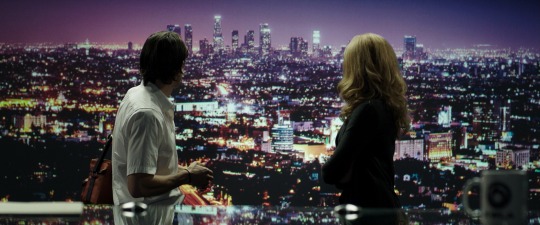
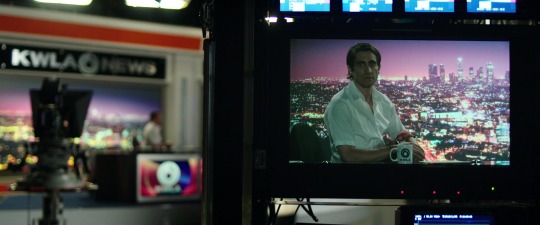

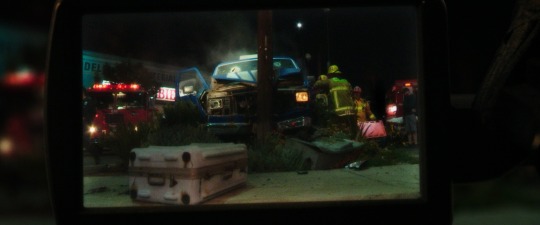
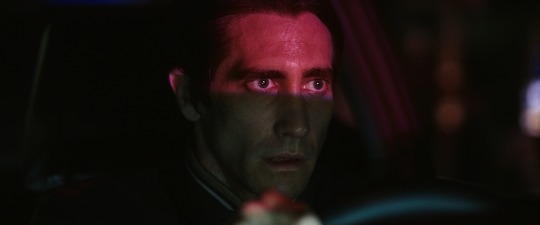

NIGHTCRAWLER (2014)
Directed by Dan Gilroy
Cinematography by Robert Elswit
638 notes
·
View notes
Text
LEGEND (2015)

One of my favourite romantic comedies this year was Legend. Although its certainly no ‘Sweet Home Alabama’ or ‘She’s All That’ and doesn’t conform to the typical formula that leaves all our girlfriends begging for more and saying “why can’t you be more like that guy?” Legend was funnier than hell with a sweet street romance that left me feeling mushy and gushy.
(most of the time)
Legend, by definition is a gangster flick with enough guns, glam, and tailored suits to make even Tom Ford turn his head. Emily Browning and Tom Hardy spiffed up in a suit aside this movie is all eye candy. Highly stylized with eye popping club interiors and the winding exteriors of East London street sides, not to mention mouth watering classic auto-mobiles of the 60′s. The wheels aren’t the only thing classic in this flick, the soundtrack is as well, from ‘Booker T and the MG’s’ to ‘Hermins Hermits’ it’s sure to keep your fingers snapping and feet tapping.
Tom Hardy, whether you’re sick of his inaudible mumbo jumbo or not does it again, but this time in his native tongue. He’s hilarious whether he meant to be or not as thee exposed nerve Ronnie, and smooth and often times endearing as ‘Thee more attractive’ Reggie, giving them both enough individuality to truly distinguish them from one another and mask the fact that he’s one man playing two. Legend is by no means a gangster masterpiece and probably never will be but it certainly is a damn good time to watch.
Sincerely,
Mr. O’D
0 notes
Text
Willow Creek (2013)
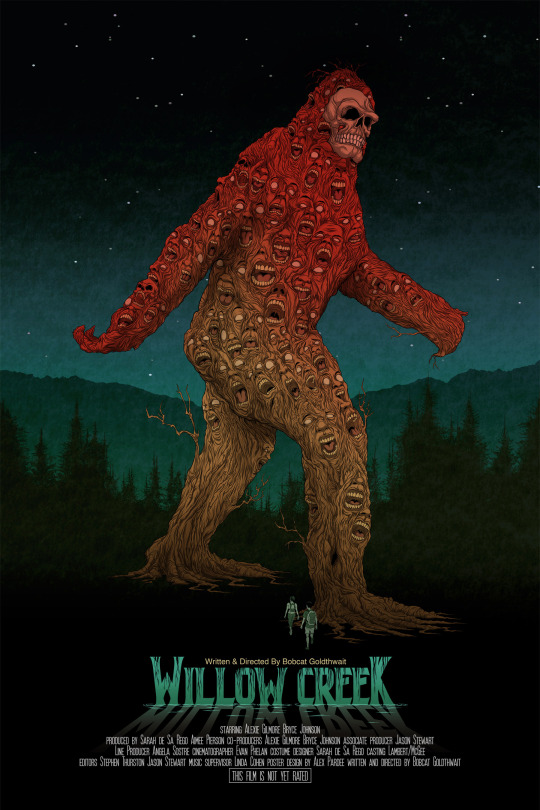
Willow Creek sucked Bigfoots dick.
cool poster though
Sincerely,
Mr. O’D
0 notes
Text
The Revenant (2015)
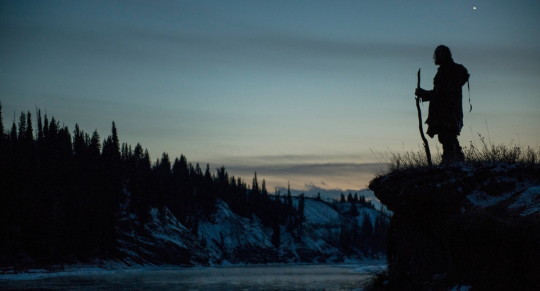
If I had to pick a favorite film of 1962 it would have to be John Ford’s The Man Who Shot Liberty Valance, a film remembered best for the words “when legend becomes fact, print the legend.” Hollywood, like American popular history, is a legend churning industry. Nothing wrong with that. If Hugh Glass’ legend is to be believed he would have spent part of his 30s as a sailor (possibly captain) before being imprisoned with an unidentified cohort by Jean Lafitte and his band of French pirates, who terrorized the waters around the Galveston Bay area, the same bay immortalized by Glenn Campbell and affluent man-child/lizard-human/perpetual blinker Robert Durst, who tried unsuccessfully to dispose of Morris Black’s dismembered remains in those dark waters. The terms offered by Lafitte amounted to piracy or death, a deal reluctantly struck only to realize that Glass didn’t exhibit the ethical debauchery required to live as a buccaneer. Upon this recognition he was doomed to the plank, a fate he and his friend narrowly and conveniently escaped when his captors curiously left them alone on the ship in order to go ashore. From there they allegedly swam for two miles to the mainland where they avoided the Karankawas, a rumored cannibal tribe that inhabited that area. Next they trudged inland without maps or knowledge of the land avoiding Comanche, Osage, and Kiowa’s for no less than 1,000 miles only to end up the prisoners of a Wolf Pawnee tribe who promptly burned his companion alive. Glass avoided a similar fate by bowing and offering the Brave a package of vermillion which not only bought him time but found him an honorary son of the tribe. During this time he adopted valuable survival skills, got married, and fought alongside his captors. From this wary ordeal Glass would only continue to suffer hardships as an ill-fated mountaineer during the 1820’s fur trade. This sounds like a hell of a movie.
Beaver fur was used to make felt hats during this period, making this unfortunate rodent a target for enterprise along the Missouri River. William Henry, a lead miner turned fur trader (play in the Revenant by Domhnall Gleeson), started the Rocky Mountain Fur Company with Lieutenant William Ashley. Their operation cut out the native middleman by killing beavers, storing, and delivering the furs directly. This kill/harvest/sell practice was accomplished by means of keelboat, which would transport the trappers and goods down Yellowstone River to their fort, named after William. The operation required this company to sift through St. Louis riffraff for men willing to hunt, haul, and battle the western elements.
Alejandro G. Iñárritu’s The Revenant begins with a tracking shot not far above the forest floor, the provincial soundscape performing its lush symphony as Hugh Glass (DiCaprio) lurks upstream in the Great Plains forest with his fictional Pawnee son (Forrest Goodluck) and his flintlock rifle. Those of you familiar with the name Emmanuel Lubezki know that this scene is achingly beautiful. He just may be unrivaled in his aptitude for capturing nature unscathed and stunning, his talent perhaps best known/utilized by frequent collaborator since 2005, Terrence Malick. Their synthesis in The New World practically wrote a new cinematic language and you can certainly sense its influence on this film from the very start (as well as Soy Cuba, The Mirror, Shadows of Forgotten Ancestors, Saving Private Ryan, Sorcerer, Apocalypse Now, Aguirre, The Passion of the Christ, and the list goes on. I’m not complaining about its derivative/reverent style btw). The placidity of this locale is juxtaposed with frenzied mountaineer filth; carcasses, snot, mud, and other varieties of Hard to be a God style grime. Soon after experiencing this abrupt shift in manner, an Arikara hunting party ambush punctually kills the majority of mountaineers/fur-traders in a signature seemingly unbroken sequence. The action dually alerts us to the dangers of this territory, with death encroaching from above and all around, and Glass’ firm skill for survival. The mountain men barely make their way to a nearby raft where they take fleeting refuge with the hunting party in rapid pursuit. After an undisclosed amount of time on the aforementioned raft Glass advises Henry to head into the mountains and ditch the keelboats in hopes to avoid another ambush. Henry abides despite the loud bellyaches of super villain John Fitzgerald (Tom Hardy), who embodies all forms of white frontier evil and sets himself up as Glass’ diametric opposite within sixty seconds of enlightening diarrhetic dialogue. This diatribe of detestation and jealousy is only a warm up for the superfluous misdeeds to come.
While traveling and hunting ahead of his cronies, Glass unintentionally steps in between a computer generated mother grizzly and her cubs. This leads to some gnarly maternal carnage, all made to look like one take. After being torn to ribbons and managing to still somehow kill the bear, Glass is discovered by his men bleeding out without much of a chance of survival. This section of The Revenant seems the closest to gathered fact. According to legend, he was transported by a makeshift litter and carried for two days. The difficulty of the journey + the seemingly inevitable fate of Glass + the pursuing Arikara’s forced Henry to hire two volunteers to hang back with Glass until he expired, after which they were to give him a proper burial. For their troubles they were to receive $80. The men who volunteered were an older man, the cinematically wicked Fitzgerald, and a 19 year old James Bridger (a persistently petrified or livid Will Poulter). These men bailed on Glass, leaving him without a gun and other survival necessities which led to his 200 mile feat, a journey that easily could have sufficed a feature length film. In The Revenant, Iñárritu embellishes this situation by having Fitzgerald shank Glass’ son right in front of him before partially burying him alive and leaving him to expire. Just as Glass’ son serves as nobility badge, his death further provides validation for the vengeance to come.
I’m all for the art-house/chartbuster adventure hiding somewhere in The Revenant, unfortunately Iñárritu can’t help but pile on atrocities to intensify our bloodlust. This movie has three primary incentives (survival, revenge, and suffering) and each is capably serviced by the skillful execution of the action. Where it struggles most is emotional resonance, mostly evoked in historically counterfeit flashbacks that resurrect sad memories of a deceased Pawnee wife killed by a callous white soldier. I’ll admit that I responded to the images of Glass and his young, badly burnt son, if only because I myself have a son right around the same age and the thought of any harm coming to him fills me with gloom, terror, and horror. I also have heaps of hatred for the genocide of indigenous Americans. From these memories the movie desperately mangles a divine transcendence to float above the ugliness of the comparatively blunt hard-to-kill-man vs. indifferent-nature minimalism of the tale itself. Minimalism isn’t a register Iñárritu has the patience for. Speaking for myself, I preferred the survivalist problem-solving scenes far more than the vicious milking of sentiment. For example, the Dersu Uzala blizzard sequence trumped the horse flying off the cliff and the ensuing Tauntaun madness. But maybe that’s just me.
I also didn’t appreciate the screenwriter bending over backwards to ensure that Glass fit neatly as an honorable hero for our hypersensitive modern times. History tells a different story and contrivances involving an Arikaran woman being raped by French traders, rescued by dignified Glass, and eventually sparing him due to his altruism border on insulting. This is the type of Hollywood whitewashing is for the fainting couch crowd. Truth is at least funnier than fiction. Glass trekked to Fitzgerald and Bridger but didn’t attack them with a mini-scythe, instead he was convinced to forgive and forget with the help of $300. And the fate that Hardy’s Fitzgerald suffers is actually comparable to how the real Glass met his end, the same tribe taking his life along with two fellow trappers. I’m all for Hollywood mythologizing and perpetuating fictional American history if it’s done right. I’m even ok with the shameless PR campaign so frantic to appoint The Revenant to art-mimicking-reality-legend. Here’s hoping that this movie’s imminent box office and award success leads to the financing of straightforward and less upright tales of the 1820s west.
1 note
·
View note
